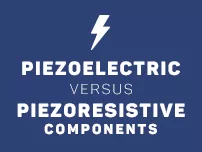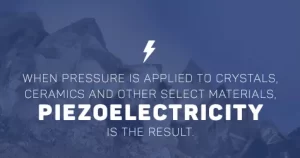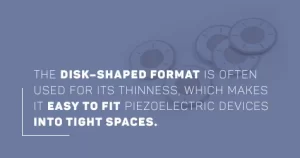Jump To: Piezo Effect | Piezoresistive Effect | Piezoelectric vs. Piezoresistive | Summary

The word “piezo” is derived from piezein, which is Greek for physical pressure in one form or another. Piezo devices, which come in piezoelectric or piezoresistive varieties, are activated through some form of physical pressure. The effects of such pressure depend on the type of device in question.
So, what are piezo devices used for, and how exactly do the effects of each piezo type appear? The following article addresses a number of piezo concerns, such as:
As you read along, you will likely come to discover the role of various piezo components in your day-to-day, such as in your computer and peripherals, as well as in the alarms and sensors that safeguard your living quarters.
When pressure is applied to crystals, ceramics and other select materials, piezoelectricity is the result. This is due to the piezo property getting stressed in one manner or another, be it through vibrations or an alternative form of pressure. As a result, a voltage charge is produced. This charge, in turn, can be used to power a variety of operations.

The piezoelectric effect is a clear-cut process. The degree of piezoelectricity correlates to the degree of pressure that the piezo property endures. The piezoelectric effect can also be applied in reverse. When a charge is inflicted on a piezo property, it produces a mechanical reaction or twitch. Consequently, piezo properties are useful for frequency, sound and voltage generation, as well as various forms of detection and measurement. Due to this, many types of modern technology rely on the piezoelectric effect.
A perfect model for the reverse application of the piezoelectric effect is in the super–efficient and economical noise device — alternately known as the piezo tweeter — used in low–cost speakers, where it has become a viable alternative to the costlier magnetic coil models. The piezoelectricity behind the tweeter is generated by vibrations that are applied to crystals.
The crystal changes form depending on the amount of pressure it receives. When high frequencies are generated through the speaker, the crystal reacts. In effect, piezoelectricity plays an important role in modern–day sound systems.
The low–cost crystal used in the piezo tweeter only generates upper–range frequencies of 4 kHz or more. As such, it does not necessitate any crossover with inert parts in order to function as a sound generator in speaker systems. In some cases, based on how the system is constructed, the piezo horn is safeguarded from lower frequencies with the placement of low–cost electrolytic capacitors.
French physicists Pierre and Jacques Curie first unveiled the newly-discovered piezoelectric effect in 1880. However, the team didn’t recognize the converse form of the effect, but this was demonstrated the following year in math terms by Franco-Luxembourgish physicist Gabriel Lippmann. He would eventually win the Nobel laureate in physics for developing an early form of color photography that relied on interference.

Pressure is also the cause of the piezoresistive effect, yet the defining factor here is the resistance change of the piezo property. Whereas the piezoelectric effect is the charge or voltage that generates from pressure, the piezoresistive effect is marked by changes in resistance of materials as the result of pressure. In both cases, pressure plays a key role in the effects that surround piezo properties.
Piezo resistors are the most fundamental devices to run on the piezoresistive effect. Piezoresistive devices generally consist of semiconductor materials and are made for the measurement of pressure. The degree to which pressure is applied will help to determine the intensity of the effect and its usefulness in select applications.
The piezoresistive effect was recognized as far back as 1856 by Irish physicist Lord Kelvin, who noted a phenomenon in metal devices that fit the basic description of the effect. However, a century would pass before the piezoresistive effect was formally identified in 1954 by C.S. Smith, who detailed examples of the process at work in sample of germanium and silicon.
Sensors and transducers are the two types of devices that use both piezoresistive and piezoelectric effects. Measurement is among the foremost uses of such devices, detection is another.
The purpose of a transducer is to transform energy. The function of a piezoelectric transducer is twofold — to turn pressure, vibration and other forms of mechanical energy into electrical currents, as well as to generate vibrations and noises from electrical energy. In basic terms, transducers make it possible to convert pressure into power and motion, and provide the ability to turn energy into sound.
Piezoresistive transducers transform vibrations and pressure into correlative rates of resistance. However, such devices don’t transform mechanical energy into electrical currents. Unlike piezoelectric transducers, piezoresistive transducers are unable to transform resistance into energy. The two types of transducers are made in a vast array of designs.
Piezoelectric devices are typically designed in disk form, though the measurements vary. At the center of each disk is the piezo crystals. The disk–shaped format is often used for its thinness, which makes it easy to fit piezoelectric devices into tight spaces and along flat surfaces where other designs, shapes and formats would be awkward.

Piezoresistive transducers are typically bigger because of their reliance on semiconductor matter. Therefore, an array of designs and enclosures are made for piezoresistive transducers, which transform mechanical energy into resistance, and are most often used for the measurement of pressure.
The purpose of a sensor is to identify and trace movement, intensity, temperatures and length. A sensor allows engineers to determine where something is headed and the rate at which it travels, as well as characteristics such as whether it’s warm or cool, large or small. This is accomplished through the conversion of a property, for example, how a thermocouple derives translatable voltage from levels of heat and coldness.
Sensors that employ the piezoelectric effect are used to trace a range or measurements, including force and strain, which are then transformed into currents. While piezoelectric transducers and sensors are often lumped into the same category, the latter only function as sensors and do not perform reverse functions. Essentially, sensors are built to do what the name implies and nothing more.
As electromechanical devices, piezoelectric sensors work linearly across bandwidths of high frequency. Designed in various measurements, piezoelectric sensors are valued for their strength and responsiveness. The technology has been used in everything from intruder alarms, key fobs, smoke alarms and wristwatch alarms, as well as in medical devices, microwave ovens, computer motherboards and exercise equipment.
In contrast to the piezo utilized by a sensor, the piezoresistive device is generally quite sophisticated in terms of design. For example, a sensor can use crystal silicon, film metal and various other materials. As one might expect, the material of choice will largely be determined by the amount of money allocated for a given project, as well as the application in question.
In most measurements of pressure, the piezoresistive sensor is a key component of the study. In recent times, the most commonly used sensors generate pressure from mono–crystalline. Constructed with semiconductor technology, the piezoelectric effect of such devices is noticeably more intense than those on display with more conventional gauges.
As evidenced by these results, it can be noted that sensors of the mono–crystalline variety are more sensitive than other types of piezoelectric devices. Piezoresistive sensors are made in a variety of designs and offer linear performance at reliable ranges of temperature. Such devices are also dependable at tracking changes in pressure.
When it comes to conducting materials, including semi–conducting materials, transformations in the spacing of inter–atomic properties due to strain are what impact the bandgaps, and this renders it much easier for electrons to be lifted to the conduction band. As a result, the resistive qualities of the material undergo a change. Across a select range of pressure, the effect is linear.
In metals, a change in piezoresistance is generally the result of geometric alterations that stem from applications of mechanical force. Despite the minute nature of these changes, the piezoresistive effect is still consequential. In physics terms, the piezoresistive effect can be described as linear I–V curve with a volume effect and symmetric effect, but with no polarity or switch function.
In comparison to changes that result from geometric factors, certain types of metal show piezoresistance levels that are far greater. For example, the piezoresistivity of platinum alloys is greater, and this combines with the geometric impact to triple the sensitivity. With nickel, this effect is even more pronounced. Basically, an application can utilize the effect to certain levels of intensity based on the choice of metal.
With semiconductor materials, the piezoresistive effect is greater than the geometrical effect. This is evident in various materials in which the piezoresistive effect occurs, such as in silicon carbide, germanium, crystal silicon, and both polycrystalline and amorphous silicon. This makes it possible to produce semiconductor pressure with a degree of sensitivity that is highly coefficient.
![]()
Due to this sensitivity, however, semiconductor strain gauges are more difficult to manage than metal strain gauges when environmental factors are considered.
In comparison to the majority of metals studied, the gauge factors of silicon can be twice the magnitude. As a result of the shifting that takes place, the carriers redistribute across valleys of varying mobility that rely on the flow of currents.
Due to the transformation of valley shapes, mass change occurs as a minor result of the shifting. The effects are more pronounced in p–conducting silicon, which also sees significant alterations in mass and hole transfer.
A significant example of the piezoresistive effect has been known to occur with structures consisting of micro–fabricated hybrids of silicon and aluminium. In examples such as these, the bulk value is surpassed by the piezoresistive coefficient. A similar effect has been employed with sensor devices that utilize silicon. The effect is well on display inside of any computer tower, where various parts of the motherboard and memory cards feature hundreds of silicon sensors.
For the application of polycrystalline, amorphous and single–crystal silicon, as well as for geranium and other materials, semiconductors rely on the piezoresistive effect. Today, devices that rely on piezoresistive silicon are the components of choice in applications where analog and digital circuits are integrated with one another.
A wide array of marketed components rely on the piezoresistive effect, including acceleration and pressure sensors, both of which use the effect with silicon. The intensity of the piezoresistive effect in devices that use silicon has advanced research and led to the construction of other devices that rely on crystal silicon.
One example is the semiconductor hall sensor, which has only been able to reach newfound exactitude after appropriating schemes that eradicate signal contributions that stem from mechanical forces.
Resistors that consist of piezoresistive matter are known as piezoresistors, which are typically employed in the gauging of mechanical stress. These are the least complicated piezoresistive components. The piezoresistor is easy to fabricate with a vast array of applicable matter. The most uncomplicated type of sensors in this category are diffused resistors.
Piezo devices have proven to be highly reliable for the measurement applications. The technology has also been utilized for test apps, safety devices, and numerous applications in the military, medical and automotive sectors. Piezo components are even used in the pickup components along the fret boards of eclectic guitars.
Piezoelectric devices transform forms of pressure, as well as vibrations and other types of mechanical force, into electrical currents. The reverse effect can also be employed with piezoelectric devices. On the other hand, piezoresistive components can only generate electrical currents and volts from mechanical energy, and not the other way around.
Due to more elaborate construction, resistive devices are generally costlier. Regardless, both types of can be employed for an infinite array of creative uses.

APC International specializes in the design, pressing, firing, machining and testing of customized piezoelectric devices and ceramics. At APC, we custom manufacture piezoelectric discs, plates, rings and transducer components. It is our mission to satisfy the specifications of each custom request brought to our team of experts.
APC International also manufactures piezo transducers and flow sensors, as well as level sensors and ultrasonic components. Our team is equipped to meet a range of customer specifications on the design of piezo devices. At APC, we match parts, perform electroding, tighten tolerances and perform testing.
The engineers and material scientists here at APC International come from extensive backgrounds in the design and use of piezoelectric devices.
The products designed and customized at APC International have served a multitude of sectors, including the automotive, aerospace, medical and defense industries. To learn more about our piezoelectric components, read more info on our site.
Top Uses of Piezoelectricity in Everyday Applications
Piezo Buzzers vs. Magnetic Buzzers
Principles of Piezoelectric Energy Harvesting